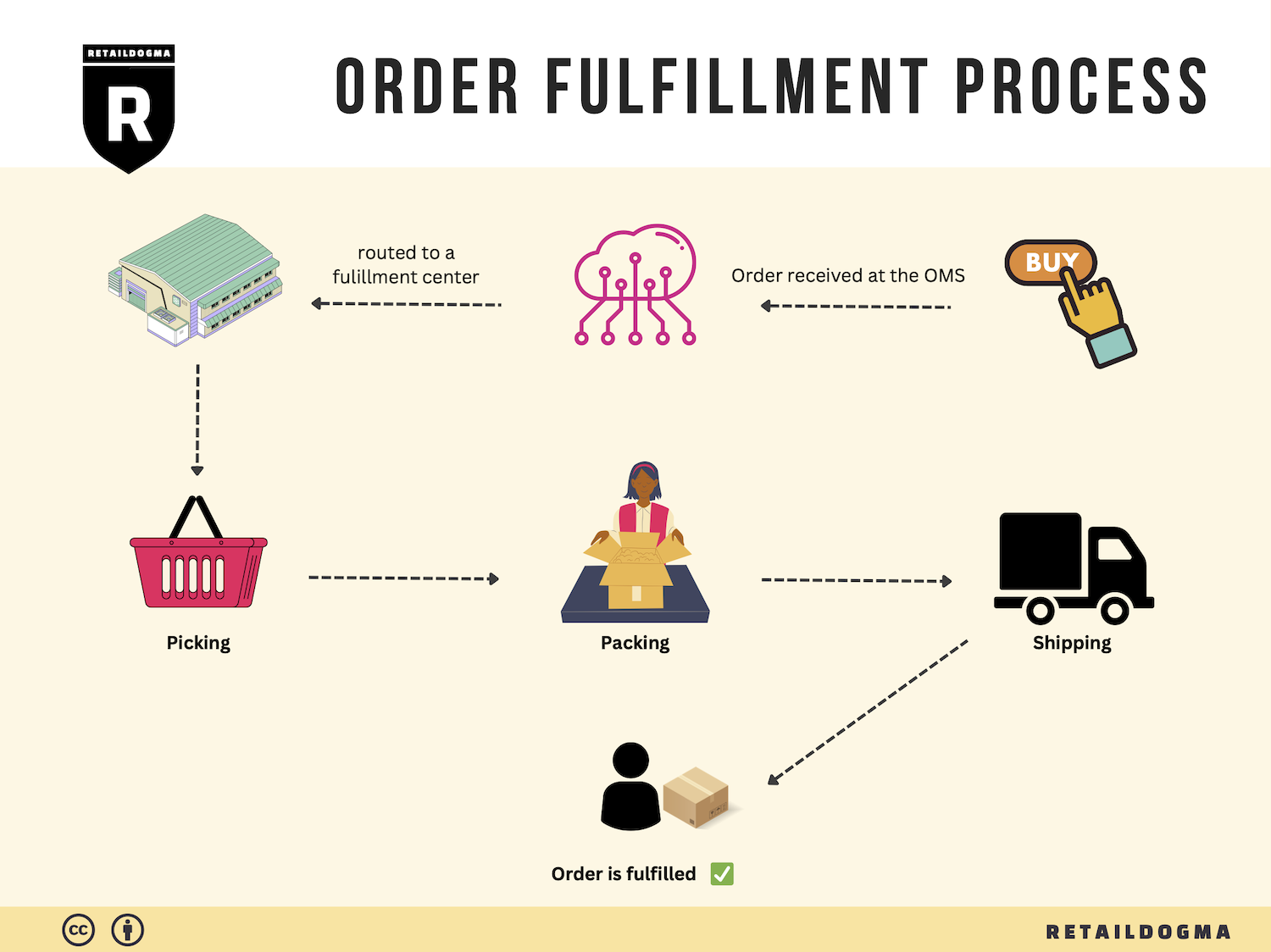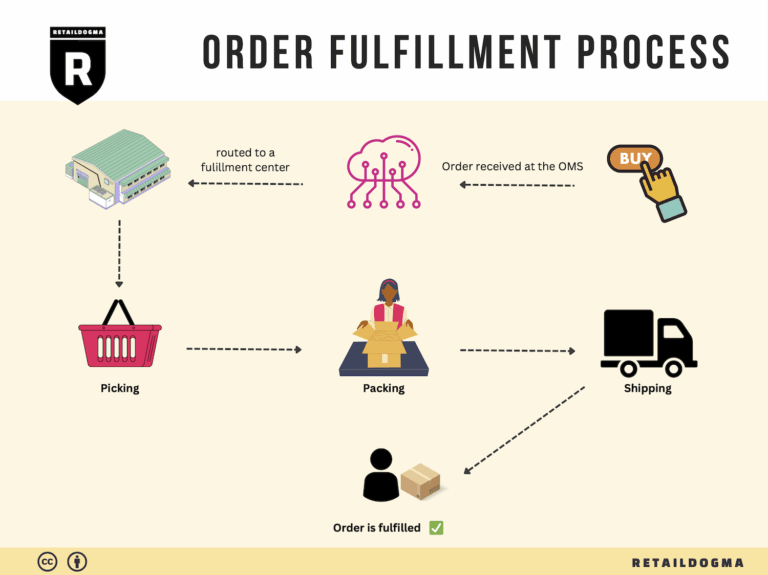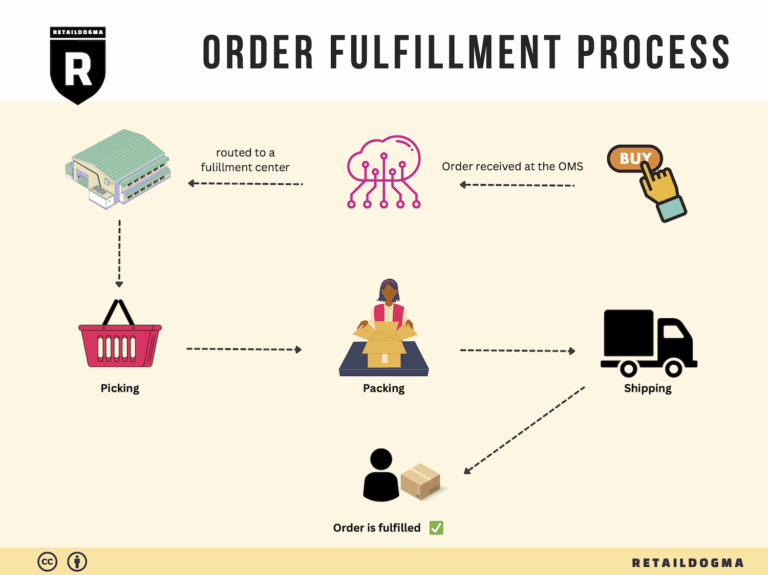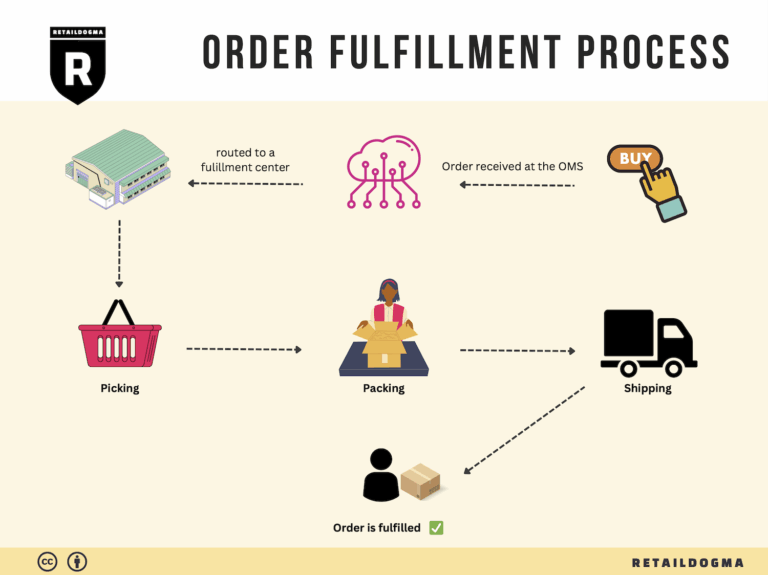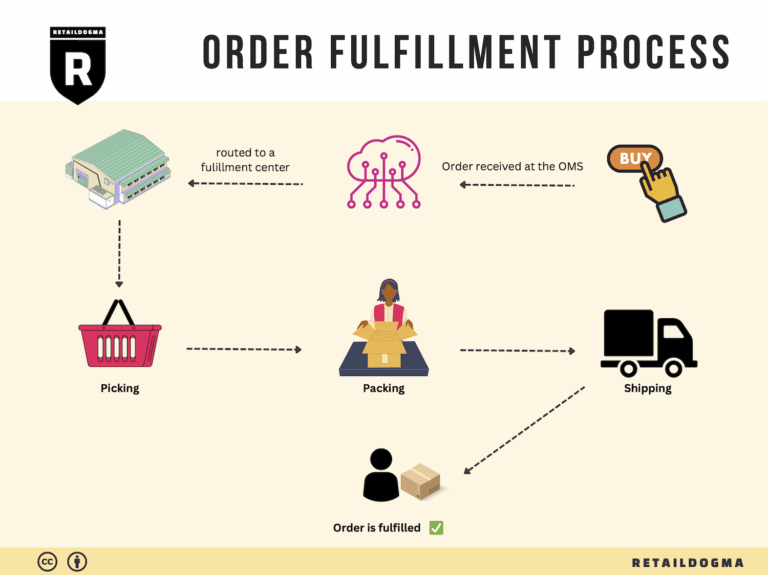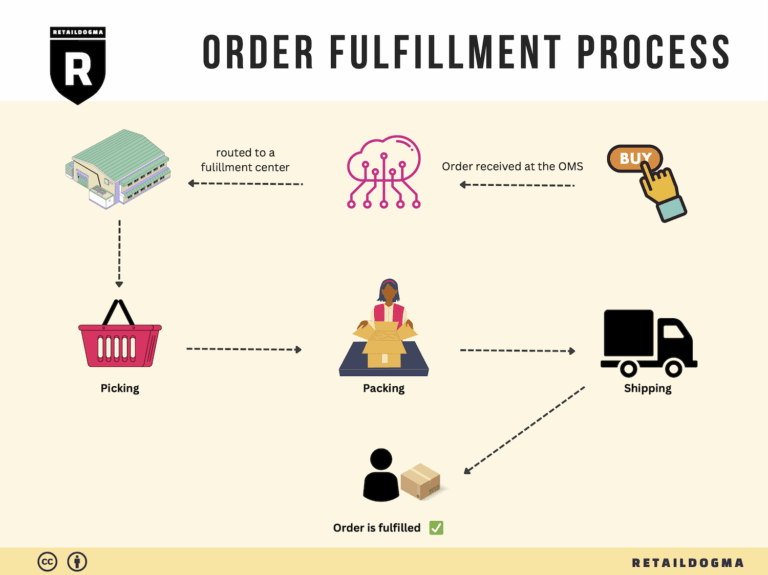Ecommerce Fulfillment Services: The Ultimate Guide (2025)
What is E-commerce Fulfillment? An Introduction for Growing Businesses
As an e-commerce business grows, many owners quickly find themselves overwhelmed by the logistical challenges of packing and shipping orders. The excitement of increased sales can quickly turn into stress as you juggle inventory management, shipping timelines, and customer expectations. This is where e-commerce fulfillment comes into play, serving as a crucial backbone for your operations.
E-commerce fulfillment refers to the entire process of getting a product from your warehouse or fulfillment center to your customer’s doorstep. It encompasses several steps, including inventory management, order processing, picking and packing, shipping, and returns handling. Understanding and optimizing this process can significantly enhance customer satisfaction and streamline your operations.
In this guide, we will explore various fulfillment models available to growing businesses, including Third-Party Logistics (3PL) and Fulfillment by Amazon (FBA). Each model has its own set of advantages and considerations, allowing you to choose the one that best aligns with your business goals and customer expectations.
We will also delve into the core services that fulfillment partners offer. These services can range from basic inventory storage and order packing to more complex solutions like kitting, assembly, and returns management. By understanding these offerings, you can better assess which services will provide the most value to your business.
Choosing the right fulfillment partner is another critical aspect we will cover. With numerous options available, selecting a partner that not only meets your logistical needs but also aligns with your brand values is essential. We will provide practical tips on what to look for in a fulfillment partner, ensuring you make an informed decision.
Finally, we will address the often-complex topic of pricing. Understanding the cost structure of fulfillment services is vital for maintaining healthy margins while delivering exceptional service to your customers.
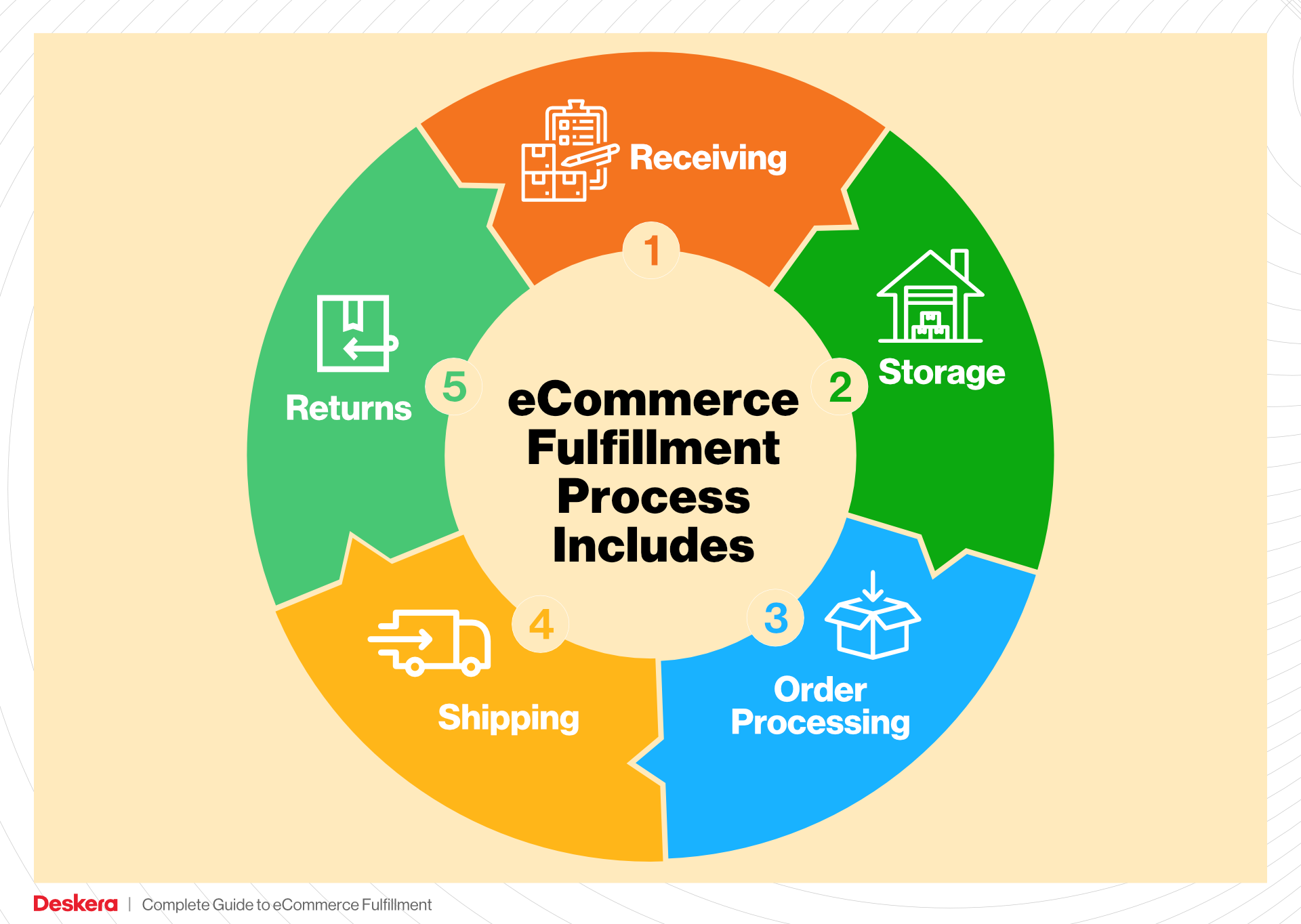
The goal of this guide is to empower e-commerce business owners and operations managers to make informed and strategic decisions about their logistics. By equipping yourself with the knowledge of e-commerce fulfillment, you can alleviate the overwhelm and focus on what truly matters—growing your business and delighting your customers.
What You’ll Learn In This Guide
- What is E-commerce Fulfillment? An Introduction for Growing Businesses
- The Order Fulfillment Process: From ‘Buy’ Button to Customer’s Door
- Comparing Fulfillment Models: In-House vs. 3PL vs. Dropshipping
- A Deep Dive into Amazon FBA: Pros, Cons, and Who It’s For
- Core Services Offered by Fulfillment Centers
- How to Choose a Fulfillment Partner: A 6-Point Checklist
- Understanding Fulfillment Pricing: A Breakdown of Common Fees
- Frequently Asked Questions (FAQs) about Fulfillment
- Conclusion: Is Outsourcing Fulfillment the Right Move for Your Business?
- Important Disclaimer
The Order Fulfillment Process: From ‘Buy’ Button to Customer’s Door
1. Receiving Inventory
The order fulfillment process begins with receiving inventory at the fulfillment center. This step involves the acceptance of goods from suppliers or manufacturers. As products arrive, they are checked against purchase orders to ensure accuracy in quantities and specifications. This is where the concept of Stock Keeping Units (SKUs) becomes crucial. Each product is assigned a unique SKU, which facilitates efficient tracking and management of inventory.
Why is this step important? Proper inventory receiving ensures that the fulfillment center has accurate stock levels, which directly impacts order fulfillment efficiency. Errors in this stage can lead to stock discrepancies, resulting in delays and potential customer dissatisfaction. By establishing a systematic receiving process, businesses can maintain a reliable inventory that supports timely order processing.
2. Warehouse Storage
Once the inventory is received, it is moved to the warehouse storage area. This involves organizing products in a manner that optimizes space and accessibility. Fulfillment centers often utilize various storage solutions, such as shelving, bins, and pallets, to manage different types of inventory effectively. Key terms associated with this step include slotting and inventory rotation.
Slotting refers to the strategic placement of products within the warehouse to minimize travel time during order picking. Effective warehouse storage is crucial for maintaining an organized inventory and ensuring that products can be easily located when needed. Additionally, implementing inventory rotation techniques, such as FIFO (First In, First Out), helps prevent product obsolescence, especially for perishable goods. Properly managed warehouse storage not only enhances operational efficiency but also reduces the risk of errors during the picking process.
3. Order Picking
The next phase in the order fulfillment process is order picking. This is where warehouse staff retrieve items from their designated storage locations to fulfill customer orders. A pick list is generated, detailing the items needed for each order, along with their corresponding SKUs and locations within the warehouse. This step is vital for ensuring that the correct items are selected and prepared for shipping.
Efficient order picking is essential for maintaining customer satisfaction, as delays or inaccuracies can lead to missed delivery deadlines and increased return rates. Various picking methods can be employed, such as single order picking, batch picking, or wave picking, depending on the volume and nature of orders. By optimizing the picking process, businesses can enhance productivity and speed, ultimately improving the overall customer experience.

4. Order Packing
Once the items have been picked, they proceed to the order packing stage. This involves carefully packaging the products to ensure they arrive at the customer’s door in perfect condition. Key considerations during this step include choosing appropriate packing materials, minimizing shipping costs, and providing an excellent unboxing experience. Terms like dimensional weight pricing often come into play here, as carriers may charge based on the size of the package rather than its actual weight.
Packing is crucial not only for protecting the products but also for branding and customer perception. An aesthetically pleasing and secure package can significantly enhance the customer experience, encouraging repeat purchases. Moreover, efficient packing processes can reduce shipping costs and improve delivery times, making it a critical component of the fulfillment cycle.
5. Shipping & Delivery
The final step in the order fulfillment process is shipping and delivery. Once the orders are packed, they are labeled and handed over to shipping carriers for delivery. This phase involves selecting the most appropriate shipping method based on factors such as cost, speed, and destination. Here, the concept of last-mile delivery becomes relevant, as it refers to the final leg of the shipping journey from the distribution center to the customer’s doorstep.
Effective management of the shipping process is crucial for ensuring that orders are delivered on time and in good condition. Businesses must monitor shipping performance and stay informed about carrier options to optimize costs and delivery speed. By leveraging technology, such as tracking systems and automated shipping software, e-commerce businesses can enhance visibility and communication with customers throughout the delivery process.
In conclusion, understanding and optimizing each step of the order fulfillment process—from receiving inventory to shipping and delivery—enables e-commerce businesses to scale effectively, enhance customer satisfaction, and drive sales. By partnering with a reliable third-party logistics (3PL) provider, businesses can streamline these operations and focus on their core competencies.
Comparing Fulfillment Models: In-House vs. 3PL vs. Dropshipping
Fulfillment Models Overview
In the ever-evolving landscape of e-commerce, choosing the right fulfillment model is crucial for operational efficiency and customer satisfaction. The three predominant models—In-House Fulfillment, Third-Party Logistics (3PL), and Dropshipping—each come with distinct advantages and disadvantages that can significantly impact a business’s scalability and overall success. Below is a comparative table to help you understand these models better.
| Model | Who Handles Inventory | Best For (Business Stage) | Key Advantage | Key Disadvantage |
|---|---|---|---|---|
| In-House Fulfillment | The business itself | Established businesses with stable sales | Full control over inventory and processes | Higher overhead costs and complexity |
| Third-Party Logistics (3PL) | 3PL provider | Growing businesses scaling operations | Access to expertise and scalability | Less control over processes and inventory |
| Dropshipping | Supplier | Startups and low-capital businesses | Low upfront costs and inventory risk | Lower profit margins and longer shipping times |
In-House Fulfillment
In-house fulfillment refers to the process where a business manages its inventory, order processing, and shipping internally. This model is typically favored by established businesses that have stable sales and the resources to maintain their own warehousing and logistics operations.
Key Advantages: One of the primary benefits of in-house fulfillment is the full control it offers over inventory and processes. Businesses can implement tailored workflows, ensure quality control, and manage customer relationships directly. This model also allows for greater flexibility in handling returns and exchanges, as all operations occur under one roof.
Key Disadvantages: However, the in-house model comes with significant overhead costs, including warehousing, staffing, and technology investments. As a business grows, the complexity of managing logistics can escalate, leading to potential inefficiencies and challenges in scaling operations. The need for a dedicated team and infrastructure can strain resources, particularly for smaller businesses looking to expand.
Third-Party Logistics (3PL)
Third-party logistics (3PL) involves outsourcing fulfillment processes to a specialized logistics provider. These companies offer a range of services, including warehousing, inventory management, order processing, and shipping. This model is particularly beneficial for growing businesses that need to scale their operations without the burden of managing logistics internally.

Key Advantages: A significant advantage of using a 3PL provider is access to their expertise and technology. 3PLs often have established networks and resources that can streamline operations, reduce shipping costs, and enhance delivery speed. They also allow businesses to focus on core activities like product development and marketing while the 3PL handles logistics.
Key Disadvantages: The trade-off for outsourcing is a potential loss of control over inventory and fulfillment processes. Businesses may face challenges in maintaining consistent service levels, especially during peak seasons. Additionally, the costs associated with 3PL services can add up, particularly if the business does not have a high volume of sales to justify the expenses.
Dropshipping
Dropshipping is a fulfillment model where the retailer does not hold inventory but instead relies on suppliers to ship products directly to customers. This model is often appealing to startups and entrepreneurs with limited capital, as it eliminates the need for upfront inventory investment.
Key Advantages: The primary benefit of dropshipping is the low upfront costs and reduced inventory risk. Entrepreneurs can start an e-commerce business without the burden of managing stock, storage, or shipping logistics. This model also allows for a wide product selection, as businesses can offer items from multiple suppliers without needing to invest in inventory.
Key Disadvantages: However, dropshipping comes with its own set of challenges. Profit margins can be lower due to reliance on suppliers for shipping and inventory management. Additionally, shipping times may be longer, which can negatively impact customer satisfaction. Businesses also have less control over product quality and fulfillment speed, making it essential to choose reliable suppliers carefully.
Conclusion
Choosing the right fulfillment model is a critical decision that can influence the growth and operational efficiency of an e-commerce business. In-house fulfillment provides control but at a higher cost; 3PL offers scalability with some loss of control; and dropshipping minimizes risk but can compromise margins and customer experience. Understanding these models and aligning them with your business stage and goals will help you make an informed decision that supports sustainable growth.
A Deep Dive into Amazon FBA: Pros, Cons, and Who It’s For
Understanding Fulfillment by Amazon (FBA)
Fulfillment by Amazon (FBA) is a service provided by Amazon that allows sellers to store their products in Amazon’s fulfillment centers. Once a seller enrolls in FBA, Amazon takes care of storage, packaging, and shipping of the products directly to customers. This service offers a comprehensive logistics solution that is especially appealing for e-commerce businesses looking to leverage Amazon’s vast infrastructure and customer base.
How FBA Works
-
Enrollment and Inventory Shipment: Sellers sign up for FBA through their Amazon Seller Central account. After enrollment, they prepare their products for shipment to Amazon’s fulfillment centers. This involves labeling and packaging the products according to Amazon’s guidelines.
-
Storage at Amazon Fulfillment Centers: Once the products arrive at Amazon’s warehouses, they are stored until an order is placed. Amazon provides a network of fulfillment centers strategically located to optimize shipping times.
-
Order Processing: When a customer places an order, Amazon handles the entire process—from picking the product from the warehouse to packaging it and shipping it directly to the customer.
-
Customer Service and Returns: Amazon also manages customer service inquiries and returns for FBA orders. This means that sellers can focus on other aspects of their business while Amazon handles post-sale support.
-
Multi-Channel Fulfillment: Beyond fulfilling orders on Amazon, FBA can also be used to fulfill orders from other sales channels, such as a seller’s own website or other marketplaces, further expanding the reach of their products.
Pros of Using FBA
-
Prime Eligibility: One of the most significant advantages of FBA is that products become eligible for Amazon Prime. This boosts visibility and increases sales potential, as Prime members often prefer to purchase items that offer free two-day shipping.
-
Customer Trust: Leveraging Amazon’s brand recognition and customer service enhances trust. Customers are more likely to purchase from a seller using FBA due to Amazon’s reputation for reliable service and hassle-free returns.
-
Multi-Channel Fulfillment: Sellers can utilize FBA to fulfill orders from various platforms, not just Amazon. This allows businesses to streamline their logistics and maintain consistent customer experiences across different sales channels.
-
Scalability: FBA allows businesses to scale their operations quickly without the need to invest in additional warehousing or fulfillment staff. As demand grows, sellers can send more inventory to Amazon without worrying about logistical challenges.
-
Time-Saving: Outsourcing fulfillment to Amazon frees up valuable time for sellers, allowing them to focus on other important aspects of their business, such as product development and marketing.
Cons of Using FBA
-
High Fees: While FBA offers many benefits, it comes at a cost. Sellers face various fees, including storage fees for inventory and fulfillment fees per order. These costs can add up, particularly for low-margin products.
-
Strict Inventory Rules: Amazon has stringent inventory management policies that sellers must adhere to. Non-compliance can lead to penalties, including removal of inventory or suspension of the seller account.
-
Commingling Risks: FBA operates on a commingling model where inventory from different sellers is stored together. This can pose risks for sellers, such as receiving returns of items that are not their own, leading to potential brand reputation issues.
-
Lack of Control: By using FBA, sellers relinquish some control over the fulfillment process. This includes packaging and branding, which may not always align with the seller’s desired customer experience.
-
Inventory Limitations: During peak seasons, Amazon may impose inventory limits based on sales performance, which can restrict the ability to stock enough products to meet demand.
Who is FBA Best For?
Fulfillment by Amazon is ideally suited for:
-
Small to Medium-Sized Businesses: Entrepreneurs and small business owners can benefit significantly from the infrastructure and scalability that FBA provides, allowing them to compete with larger retailers.
-
Sellers with High Sales Volume: Businesses that have a consistent sales volume and can effectively manage FBA fees will find the service beneficial for maintaining quick delivery times and customer satisfaction.
-
Brands Seeking Trust and Visibility: New or lesser-known brands that want to enhance their credibility and visibility on Amazon can leverage FBA to build trust with customers.
-
E-commerce Entrepreneurs Expanding into New Markets: Sellers looking to reach new markets without investing heavily in logistics can use FBA to test new products and markets efficiently.
-
Businesses Focused on Growth: For companies aiming to scale quickly, FBA provides a robust solution that allows them to focus on growth strategies while Amazon manages the fulfillment side.
In conclusion, while FBA presents several advantages for e-commerce businesses—such as increased visibility, customer trust, and scalability—it’s essential to weigh these against the potential drawbacks, including costs and control issues. By understanding the nuances of FBA, sellers can make informed decisions that align with their business goals and operational capabilities.
Core Services Offered by Fulfillment Centers
Inventory Management & Warehousing
Inventory management and warehousing form the backbone of effective fulfillment operations. Fulfillment centers provide dedicated space for storing products, ensuring that businesses can maintain optimal stock levels without the overhead costs associated with owning a warehouse.
These centers utilize advanced inventory management systems that track stock in real-time, allowing e-commerce businesses to monitor their inventory levels, forecast demand, and manage stock replenishment efficiently. This reduces the risk of overstocking or stockouts, both of which can negatively impact sales and customer satisfaction.
Benefits:
– Cost Efficiency: By outsourcing warehousing, businesses save on capital expenses related to leasing or purchasing warehouse space, as well as the costs of staffing and maintaining the facility.
– Scalability: As demand fluctuates, fulfillment centers can easily adjust storage space to accommodate changing inventory needs, allowing businesses to scale operations without significant investments.
– Real-Time Data Access: With integrated software solutions, businesses gain insights into inventory levels, enabling them to make informed decisions about restocking and inventory turnover.
Pick and Pack Services
Pick and pack services are critical components of the order fulfillment process. Once an order is received, fulfillment centers swiftly locate the products within their warehouses, pick them from the shelves, and prepare them for shipping. This process involves packing items securely to prevent damage during transit and often includes labeling and documentation for shipping.
Efficient pick and pack services can significantly reduce order processing times, leading to faster deliveries. Many fulfillment centers also offer customizable packing options, allowing businesses to enhance their branding with personalized packaging.
Benefits:
– Speedy Order Fulfillment: With streamlined processes and experienced staff, fulfillment centers can often fulfill orders more quickly than in-house teams, leading to improved customer satisfaction.
– Quality Control: Professional pick and pack services include thorough checks to ensure that the correct items are selected and properly packed, minimizing errors and returns.
– Brand Enhancement: Custom packing solutions help businesses create a memorable unboxing experience for customers, fostering brand loyalty and encouraging repeat purchases.
Kitting and Assembly
Kitting and assembly services involve bundling multiple products into a single package or preparing components for assembly before they are shipped to the customer. This service is particularly valuable for businesses that sell products that require assembly or that wish to offer bundled deals to their customers.
Fulfillment centers can handle the entire kitting process, from assembling items to packaging them for shipment. This not only saves time for e-commerce businesses but also reduces the complexity of managing multiple SKUs.
Benefits:
– Enhanced Customer Experience: Bundled products or pre-assembled items can offer customers greater convenience, making it easier for them to purchase and use products.
– Reduced Labor Costs: By outsourcing kitting and assembly, businesses can focus their internal resources on core functions such as marketing and product development instead of labor-intensive assembly tasks.
– Inventory Optimization: Kitting can help streamline inventory management by reducing the number of individual SKUs that need to be tracked, simplifying the overall supply chain.
Returns Management (Reverse Logistics)
Returns management, often referred to as reverse logistics, is an essential service offered by fulfillment centers. This process involves handling customer returns efficiently, including inspecting returned items, restocking them, and managing the associated paperwork.
A well-managed returns process is crucial for maintaining customer satisfaction and loyalty. Fulfillment centers utilize technology to track returns and analyze data, allowing businesses to identify trends and areas for improvement in their products and services.
Benefits:
– Improved Customer Satisfaction: A smooth and hassle-free returns process builds trust and encourages customers to shop again, knowing that returns are manageable.
– Cost Recovery: Efficient returns management can help businesses recover value from returned products through refurbishment, resale, or recycling, mitigating losses.
– Actionable Insights: Analyzing return data enables businesses to identify recurring issues with products, leading to improvements in quality and customer experience.
In summary, fulfillment centers offer a comprehensive range of services that can streamline operations for e-commerce businesses. By leveraging their expertise in inventory management, order processing, kitting, and returns management, businesses can focus on growth and customer satisfaction while leaving the complexities of logistics to the professionals.
How to Choose a Fulfillment Partner: A 6-Point Checklist
Location & Warehouse Network
Importance:
The geographic location of your fulfillment partner is crucial for optimizing shipping times and costs. A partner with strategically located warehouses can help you reach your customers faster, thereby enhancing satisfaction and potentially reducing shipping expenses.
Questions to Ask:
– Where are your warehouses located, and how do they align with my customer demographics?
– What is the average shipping time from your warehouses to major markets?
– Do you have a network of warehouses that can provide coverage for both domestic and international shipping?
– How do you handle inventory distribution across your warehouse network?
Technology & Integrations
Importance:
A robust technology infrastructure can streamline your fulfillment operations. Look for a partner that offers integrations with your existing e-commerce platforms, inventory management systems, and shipping solutions. This not only saves time but also minimizes errors in order processing.
Questions to Ask:
– What technology platform do you use for order management, and how does it integrate with my e-commerce system?
– Can you provide real-time inventory tracking and order status updates?
– What automation features do you offer to streamline order processing?
– How do you handle data security, and what measures are in place to protect sensitive information?
Specializations (e.g., Cold Storage, Oversized Items)
Importance:
Depending on your product line, you may require specialized handling. If you sell perishable goods, for instance, a partner with cold storage capabilities is essential. Similarly, oversized or fragile items may need specific handling procedures.
Questions to Ask:
– Do you have specialized facilities for handling specific types of products (e.g., cold storage, hazardous materials)?
– What processes do you have in place for managing oversized or delicate items?
– Are there additional fees associated with specialized handling, and how are these structured?
– Can you provide case studies or references from businesses with similar needs?
Scalability & Capacity
Importance:
Your fulfillment partner should be able to grow alongside your business. As you scale, you’ll need a partner that can accommodate increased order volumes without compromising service quality.
Questions to Ask:
– What is your current capacity, and how quickly can you scale operations if my order volume increases?
– How do you manage seasonal spikes in demand, such as during holidays or promotional events?
– Are there any limitations on the types of products or volumes you can handle?
– What is your process for onboarding new clients, and how quickly can you start fulfilling orders for my business?
Pricing and Contracts
Importance:
Understanding the pricing structure is essential to ensure that your fulfillment costs align with your budget. Look for transparency in pricing and avoid hidden fees that can impact your bottom line.
Questions to Ask:
– Can you provide a detailed breakdown of your pricing structure, including storage, picking, packing, and shipping fees?
– Are there minimum volume commitments or long-term contracts required?
– How do you handle pricing changes, and what notice do you provide for any adjustments?
– Do you offer flexible pricing models based on order volume or seasonal needs?
Customer Support & Reviews
Importance:
Exceptional customer support is vital for resolving issues promptly and maintaining smooth operations. Additionally, reviews and testimonials from other clients can provide insight into the reliability and responsiveness of your potential partner.
Questions to Ask:
– What level of customer support do you provide, and how can I reach your team (e.g., phone, email, chat)?
– Can you provide references or case studies from other clients similar to my business?
– What is your average response time for support inquiries?
– How do you handle order discrepancies, returns, and other issues that may arise?
Conclusion
Choosing the right fulfillment partner is a critical decision that can significantly impact your e-commerce operations. By carefully evaluating potential partners based on this checklist, you can ensure that you select a 3PL provider that aligns with your business needs, enhances your operational efficiency, and ultimately contributes to your growth. Take the time to ask these questions and assess each partner’s capabilities to make an informed choice that will support your business objectives now and in the future.
Understanding Fulfillment Pricing: A Breakdown of Common Fees
Initial Setup Fees
Initial setup fees are often the first costs that businesses encounter when partnering with a third-party logistics (3PL) fulfillment company. These fees cover the administrative and technical tasks required to onboard your business into their system. Typically, this includes account creation, system integration with your e-commerce platform, and the configuration of inventory management tools.
The calculation of initial setup fees can vary widely among providers. Some companies may charge a flat fee, while others may base it on the complexity of your operations or the number of products you need to onboard. For instance, if your business has multiple SKUs or requires specific customizations, expect to pay higher setup fees. It’s crucial to ask for a detailed breakdown of what these fees include to avoid unexpected costs.
Receiving Fees
Receiving fees are charged when your inventory arrives at the fulfillment center. This fee covers the process of unloading, inspecting, and entering your goods into the warehouse management system (WMS).
The calculation of receiving fees generally depends on the volume and type of items being received. For example, 3PLs may charge a per-pallet or per-unit fee. If your shipment consists of bulky or heavy items, you may incur additional charges. To keep costs manageable, it’s advisable to consolidate shipments and ensure that your products are well-packaged to minimize handling time.
Storage Fees (per pallet/bin)
Storage fees are recurring costs that businesses incur for the space their inventory occupies within the fulfillment center. These fees can be calculated on a per-pallet or per-bin basis, depending on the storage solution offered by the 3PL.
The monthly storage fee typically varies based on factors such as location, warehouse demand, and the type of products stored. For instance, seasonal products may incur higher fees during peak months due to limited availability of space. It’s important to understand the storage policies of your chosen provider, including any potential overage fees if your inventory exceeds agreed-upon limits. Regular inventory audits can help prevent unnecessary storage costs by keeping stock levels optimized.
Pick & Pack Fees (per item/order)
Pick and pack fees are charged for the labor involved in retrieving items from storage, packaging them for shipment, and preparing them for delivery. This fee structure can be based on either the number of items in an order or a flat fee per order.
Calculating pick and pack fees usually involves considering the complexity of the packing process. For example, if your orders require special packaging or kitting services, the fees may increase accordingly. Additionally, providers may offer tiered pricing, where the cost per pick and pack decreases as your order volume increases. To optimize these costs, consider streamlining your product offerings to reduce handling complexity.
Shipping Fees
Shipping fees encompass the costs associated with transporting your products to customers. These fees can vary based on factors such as the shipping method, package weight, dimensions, and destination.
Most 3PL providers have partnerships with multiple carriers, allowing them to offer competitive shipping rates. The calculation of shipping fees is often based on dimensional weight (DIM weight), which considers both the weight and size of a package. To ensure you are receiving the best rates, request a shipping quote that includes multiple options from different carriers. This will help you make informed decisions based on cost and delivery speed.
Tips for Getting an Accurate Quote
-
Provide Detailed Information: When requesting a quote, be as detailed as possible about your inventory, order volume, and specific requirements. This will help the 3PL provider give you a more accurate estimate.
-
Ask About Hidden Fees: Inquire about any additional costs that may not be immediately apparent, such as fees for returns, special handling, or peak season surcharges.
-
Consider Volume Discounts: If you anticipate high order volumes, ask about tiered pricing or volume discounts that can lower your overall costs.
-
Review Contract Terms: Before signing any agreements, thoroughly review the terms and conditions. Pay close attention to clauses regarding price increases and service level agreements.
-
Request a Trial Period: If possible, negotiate a trial period to evaluate the provider’s services before committing long-term. This can help you gauge the actual costs and efficiency of their operations.
By understanding these common fulfillment pricing models and approaching your negotiations with clarity, you can better control your logistics costs and choose the right fulfillment partner for your e-commerce business.
Frequently Asked Questions (FAQs) about Fulfillment
1. What is a third-party fulfillment company (3PL)?
A third-party fulfillment company, or 3PL, provides a range of logistics services, including warehousing, inventory management, order processing, and shipping for e-commerce businesses. By outsourcing these tasks to a 3PL, companies can focus on core business activities like product development and marketing, while the 3PL handles the complexities of the supply chain.
2. How does a fulfillment center operate?
A fulfillment center operates by receiving inventory, storing it, and processing customer orders. When an order is placed, the fulfillment center picks the items from storage, packs them, and ships them directly to the customer. This streamlined process allows businesses to efficiently manage order fulfillment and improve delivery times.
3. What’s the difference between a warehouse and a fulfillment center?
While both warehouses and fulfillment centers store goods, their functions differ significantly. A warehouse is primarily a storage facility where goods are kept for extended periods, often without immediate shipping needs. In contrast, a fulfillment center is an active hub focused on quickly processing and shipping orders to customers, thereby supporting e-commerce operations.
4. How much do fulfillment services cost?
The cost of fulfillment services varies widely depending on factors such as order volume, product dimensions, storage requirements, and specific services needed (like returns handling or kitting). Typically, costs are structured around per-order fees, storage fees, and additional service fees. It’s advisable to request quotes from several 3PL providers to find the best fit for your budget and needs.
5. What services do 3PL companies offer?
3PL companies offer a comprehensive range of services, including inventory management, order processing, warehousing, packaging, shipping, freight forwarding, and returns management. Some 3PLs also provide additional services like technology integration, customer service, and marketing support, making them a one-stop solution for logistics needs.
6. How can a 3PL help my e-commerce business grow?
Partnering with a 3PL can significantly enhance your e-commerce business by providing access to expert logistics management, reducing operational costs, and improving delivery times. This allows you to scale operations efficiently, expand into new markets, and enhance customer satisfaction through reliable order fulfillment.
7. What factors should I consider when choosing a 3PL partner?
When selecting a 3PL partner, consider factors such as their service offerings, technology capabilities, industry experience, pricing structure, scalability, and customer service reputation. It’s also important to assess their fulfillment speed, accuracy, and ability to integrate with your existing e-commerce platforms.
8. Can I integrate my e-commerce platform with a 3PL?
Yes, most modern 3PL providers offer integration capabilities with popular e-commerce platforms like Shopify, WooCommerce, and Amazon. This integration allows for seamless order processing, real-time inventory management, and automated updates, enhancing operational efficiency and customer experience.
9. What is the role of technology in fulfillment services?
Technology plays a crucial role in fulfillment services by streamlining processes, enhancing accuracy, and providing real-time data. Many 3PLs utilize advanced warehouse management systems (WMS) to manage inventory, track orders, and optimize shipping routes. This technological support helps businesses improve efficiency and reduce errors in the fulfillment process.
10. What should I know about returns management when using a 3PL?
Returns management is a critical aspect of e-commerce fulfillment. A good 3PL will provide clear processes for handling returns, including restocking, inspection, and processing refunds. Understanding the 3PL’s return policies and capabilities can help you maintain customer satisfaction and minimize losses associated with returned products.
Conclusion: Is Outsourcing Fulfillment the Right Move for Your Business?
Evaluating the Benefits of Outsourcing Fulfillment
Outsourcing your fulfillment operations can be a game changer for your e-commerce business. One of the most significant advantages is time savings. By partnering with a third-party logistics (3PL) provider, you can offload labor-intensive tasks such as inventory management, order processing, and shipping. This allows you and your team to focus on core business functions like product development and marketing, ultimately driving growth.
Another key benefit is scalability. As your business grows, so do your logistical needs. A reliable fulfillment partner can easily adapt to fluctuations in demand, whether you experience a seasonal spike in orders or launch a new product line. This flexibility not only helps maintain efficiency but also enhances customer satisfaction through timely deliveries.
Moreover, expertise is a crucial factor when considering fulfillment services. 3PL providers bring specialized knowledge in logistics, technology integration, and supply chain management. They have established networks and systems that can streamline your operations, reduce costs, and improve overall service quality. By leveraging their experience, you can avoid common pitfalls that often accompany in-house fulfillment.
However, the success of outsourcing fulfillment hinges on selecting the right partner. A thorough evaluation of potential 3PL providers is essential to ensure they align with your business goals and can meet your specific needs.
Take Action Today
To determine if a fulfillment partner is the right next step for your business, consider conducting an audit of your current shipping and logistics processes. Identify pain points, inefficiencies, and areas where a 3PL could add value. By taking this proactive approach, you can make informed decisions that support your business’s growth and enhance your customer experience. Start this journey today and explore how outsourcing fulfillment can elevate your e-commerce operations.
Important Disclaimer
⚠️ Important Disclaimer
The information in this guide is for educational purposes. Fulfillment services, pricing, and platform features change frequently. Always conduct your own due diligence and consult with providers directly before making business decisions.
